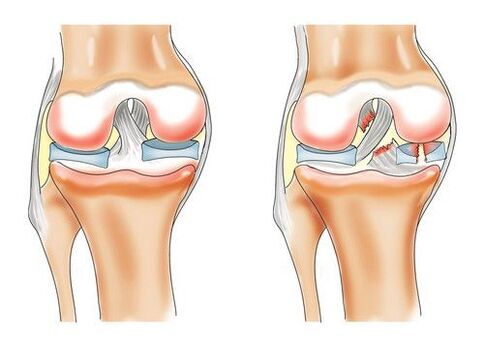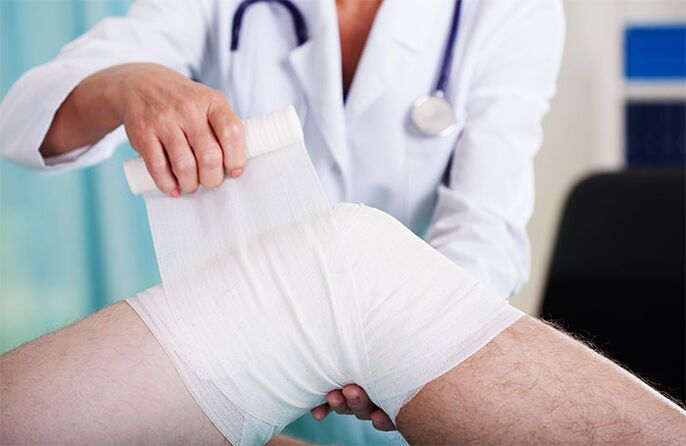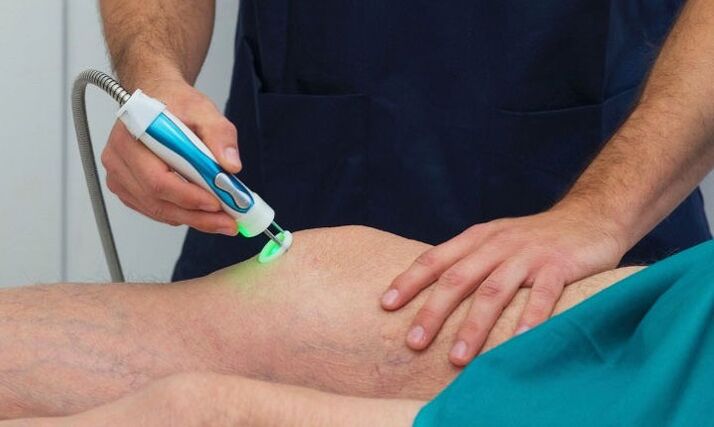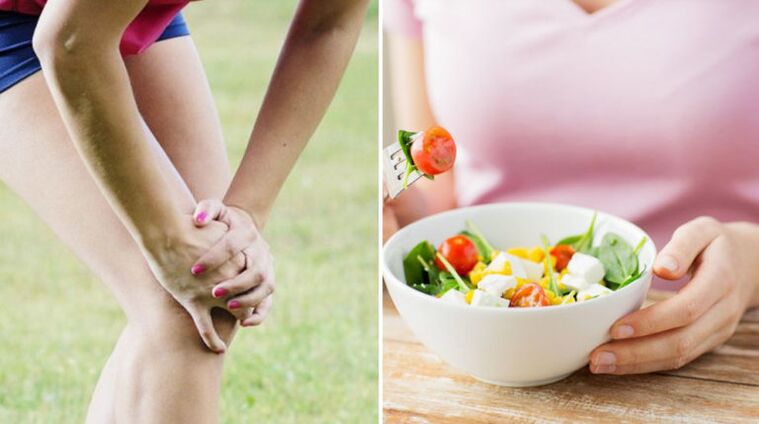
If a crunch is heard in the knee joint during movement, this is the first sign of gonarthrosis. Conservative methods of traditional and alternative medicine help prevent cartilage destruction and maintain normal motor function. Treatment should begin immediately - only in this case, rheumatologists give a favorable prognosis.
What is gonarthrosis?
Osteoarthritis of the knee is a non-inflammatory, degenerative-dystrophic disease affecting the largest joint, the knee. A rather unusual medical definition has a simpler "folk" concept - "salt deposit". The clinical picture of gonarthrosis of the joints has little to do with an excess of calcified salts in the knee joint. They do not affect the pathology and are a side effect of the disturbed metabolism.
The development of gonarthrosis of the knee joint is favored by negative processes in the hyaline cartilage, primarily by poor blood circulation in small bone vessels. The lack of nutrients and oxygen carried by the lymph flow leads to the destruction of the outer layer of cartilage in the knee.
In the early stages, the disease is extremely difficult to detect. The joint deformity occurs slowly until vitreous cartilage is drawn into the process. The anatomical structure of the ligament is modified. Haze appears, the tissue thickens, becomes thin, tears in all directions. The result of the pathology can be the complete disappearance of the cartilage, which leads to new growths in the bone tissue and irreversible curvature of the knee.
classification of the disease
The International Classification of Diseases divides osteoarthritis of the knee into seven clarifying subheadings:
- Primary gonarthrosis bilateral. The diagnosis is most commonly made in women aged 70 to 74 and men aged 60 to 64. This places the disease in the "elderly" category.
- Another primary gonarthrosis. Pathology of a knee joint due to natural wear and tear or against the background of other diseases.
- Post-traumatic gonarthrosis bilateral. Affected are people of different ages with severe leg injuries.
- Other post-traumatic gonarthroses. Unilateral, against the background of injuries and bruises of the limbs.
- Other secondary gonarthroses are bilateral. They are the result of chronic bruises, fractures or dislocations that have not completely healed. It is most often diagnosed in athletes who have heavy loads on both legs - football players, athletes, figure skaters.
- Other secondary gonarthroses. Unilateral development of pathology associated with the profession. For example, miners, metallurgists, fishermen.
- Gonarthrosis, unspecified. An unexplained etiology of the disease is diagnosed, after excluding age, occupational and genetic predisposition.
According to medical statistics, more than 10 million people of different age groups suffer from osteoarthritis of one kind or another. Every year about 3, 000 people die with a confirmed diagnosis.
causes
Osteoarthritis of the knee joint is caused by a disturbed metabolism in the knee joint, which leads to a loss of softness and elasticity of the cartilage.
Destructive processes have various causes:
- Diseases of the thyroid gland that violate the hormonal background;
- Decreased patency of blood vessels in the knee joint;
- genetic conditioning;
- natural aging;
- Past or present knee injuries of various origins;
- Obesity (more than 20% of the norm), which puts a heavy load on the knee joint;
- Inflammatory joint diseases (polyarthritis, purulent arthrosis);
- autoimmune diseases (rheumatoid arthritis);
- Specific infectious pathologies (syphilis, tuberculosis, encephalitis);
- Living in ecologically unfavorable areas, poor food and water quality.
Also, rheumatologists identify several additional reasons that lead to the development of gonarthrosis. Dysplasia in the newborn. With this diagnosis, the joint wears out faster. Changes in the collagen structure lead to damage to the protein in the connective tissue.
Symptoms depending on the degree of gonarthrosis
It is difficult to diagnose the early stages of knee osteoarthritis. Only a description of the symptoms by the patient himself and external examinations by rheumatologists make it possible to draw up a different clinical picture for each degree of progression of gonarthrosis:
- I've got osteoarthritis.Pulling pain in the knee, feeling of some stiffness, partial loss of feeling, difficulty bending the leg, especially after prolonged immobility, the impossibility of prolonged walking or running, the appearance of slight swelling. Symptoms usually resolve after rest or simple anesthesia.
- II degree osteoarthritis.At this stage, it is already possible to determine the pathology using an X-ray examination. The pain increases and occurs after any physical activity. Ailments can still be relieved by rest. In the morning it becomes more difficult to straighten your legs, it takes time to restore motor function. The symptoms are supplemented by frequent calf cramps, especially at night. A crunch is heard during the movement. The swelling of the knee joint is pronounced. There are visible signs of limb deformity.
- III degree of gonarthrosis.There are irreversible changes in the knee joint. Cartilage abnormalities can be clearly identified on an X-ray. The pain in the knee becomes constant, acute. The leg stops bending at the knee. The patient cannot walk without a cane or crutches. The swelling is significant. The anatomical shape of the knee is smoothed and given a solid look. There is a primary curvature of the spine.

diagnosis
To make a correct diagnosis, a combination of clinical manifestations of arthrosis of the knee joint and patient complaints is used. In order to clarify or rule out the causes of the disease, studies are carried out in various ways.
The standard diagnosis goes as follows:
- Drawing up an anamnesis of the disease. History of concomitant diseases, genetic predisposition, past trauma and surgical interventions, professional activities, etc.
- External assessment of the deformation of the musculoskeletal system. Gait, posture, condition of the knee joint, curvature of the legs.
- General inspection. Palpation of the lower leg, thigh, damaged joint, determining the localization of the disease.
- laboratory tests. A general blood test gives data on the absence of an inflammatory process. If the process is against the background of other diseases, then an increased rate of sedimentation of erythrocytes is noted. The content of protein, globulin and fibrinogen will differ from the normative indicators. The biochemical composition remains within the standard limits. If the progress of the pathology is in the final stages, a biopsy of the synovial fluid of the knee joint is performed.
- instrumental research. X-ray is the main and most common method of diagnosing suspected osteoarthritis of the knee. As a rule, even at the beginning of stage 2 of the disease, a rheumatologist can easily identify changes in the structure of bone tissue using a picture. The presence of comorbidities and the causes of their occurrence are diagnosed with the help of more modern and accurate equipment - MRI, CT, ultrasound, osteotincigraphy, thermography.

Treatment of gonarthrosis
Like all diseases of the joints, osteoarthritis of the knee requires systemic treatment, which is desirable when the first symptoms appear. In this case, the prognosis of therapy becomes favorable and guarantees a return to a normal lifestyle in a relatively short time.
Comprehensive treatment is aimed at eliminating the main signs of the disease:
- Discomfort, pain syndrome and muscle tone;
- improvement of the motor function of the knee joint;
- stopping the process of cartilage destruction;
- strengthening the connective muscles;
- Restoration of normal blood circulation in the knee joint.
medication
anti-inflammatory drugs
They help to cope with pain, relieve swelling caused by inflammation of muscle tissue.
chondroprotectors
Without chondroprotectors, regeneration and restoration of cartilage tissue is not possible. They are the main component of conservative treatment.
vasodilators
They are used to improve patency of intra-articular blood vessels.
Hormonal drugs
Reduce the production of the hormone cortisone to prevent the development of inflammatory processes.
Injections with hyaluronic acid
To restore intra-articular synovial fluid. As a result, the friction between the joint parts is reduced, motor skills are normalized and the elasticity of the cartilage tissue is restored.
anti-enzymatic agents
They inhibit the activity of trypsin and thus prevent further destruction of the joint. Appointment in the annex.
physical therapy
Physiological therapies have been used successfully for decades to treat osteoarthritis of the knee joint. It can be used as an independent form of therapy, for prevention or during the rehabilitation phase. Such is an integrated approach to the disease.
Most often, the following types of procedures are prescribed by a rheumatologist:
- electrophoresis with painkillers;
- ultrasonic treatment;
- magnetotherapy;
- laser exposure;
- paraffin applications;
- sludge treatment;
- exercise therapy (exercise therapy);
- Manual therapy, massage with medicinal ointments.
surgery and prosthetics
If the gonarthrosis is in an advanced stage, the knee joint and cartilage tissue are destroyed, surgical intervention is indispensable. Otherwise, the person will remain disabled for life.
Modern medicine offers several ways to solve the problem:
- arthrodesis. Complete removal of the affected tissue and knee joint. The body is freed from the focus of the disease, but the motor function of the extremity is completely lost. It is used extremely rarely if the patient has additional joint diseases.
- arthroscopy. The destroyed hyaline cartilage is removed. The operation is not very traumatic, has a short rehabilitation period. It is indicated for patients whose progress has not affected the knee joint itself.
- Periarticular Osteomy. A complex operation, the essence of which is to file deformed bones and outgrowths, with subsequent connection into the necessary anatomical structure.
- endoprosthetics. The completely destroyed knee joint is removed and a titanium prosthesis is put in its place. An effective method that allows you to forget about gonarthrosis forever. Requires careful preparation and long rehabilitation.
Traditional medicine
The use of folk recipes in combination with conservative treatment can relieve external symptoms (pain, swelling). Recipes based on bay leaf, burdock root, St. John's wort, malt and hay have proven successful. Ointments, creams, tinctures and decoctions are made from them.
These plants have anti-inflammatory and pain-relieving properties. Requires regular and long-term use to achieve visible results.
Honey-based ointments and compresses with the addition of alcohol or apple cider vinegar well relieve swelling and have a soothing effect on the affected tissues.
A nutritional blend is made from lemon and garlic to be taken orally, one teaspoon each, after breakfast and dinner. Such a recipe has a general strengthening effect on the body, increases the patency of blood vessels and nourishes the joints with useful trace elements.
It should be remembered that home treatments do not eliminate the main problem - the pathological destruction of the knee joint.

diet
Compliance with the diet is an integral part of complex treatment. An adapted diet not only helps with weight control, but also supplies bones and joints with important vitamins.
It is contraindicated for a patient with a diagnosis of gonarthrosis:
- Fried, spicy, salty, pickled food;
- fat broths;
- sweet pastries;
- fruits with a high content of acidic enzymes;
- Alcoholic drinks.
The menu should be supplemented with raw vegetables, fruits and herbs, low-fat sour-milk products, bone broths and dishes containing gelatin (jelly, jelly).
Additional methods
Regular spa treatment is required to treat gonarthrosis, at least once a year, more often if possible. Hydrotherapy, fangotherapy and manual therapy procedures can preserve the disease for a long time and prevent joint destruction.
It will take the rest of your life to keep a sore knee in stable condition. But it can become very useful for the body as a whole. Reviewing nutrition, getting rid of bad habits, playing sports, visiting resorts - the quality of life can improve significantly.
It should be remembered that self-medication, ignoring the primary symptoms and an unbearable load on the sore knee joint can very quickly turn a healthy person into a helpless disabled person.
































